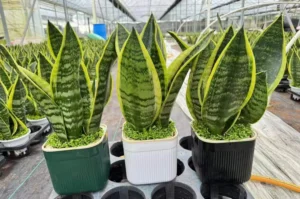Snake plants, scientifically known as Sansevieria, are not just popular houseplants because of their striking appearance and low maintenance; they’re also known for their air-purifying abilities. One of the most fascinating aspects of this plant is its ability to absorb carbon dioxide (CO₂), even at night, unlike most other houseplants. But how much CO₂ does a snake plant absorb? In this article, we explore the science behind the snake plant’s carbon absorption abilities and what makes it special among indoor plants.
Why Do Plants Absorb CO₂?
Plants absorb CO₂ as part of the process known as photosynthesis, where they convert sunlight, water, and carbon dioxide into energy and oxygen. Most plants perform this function during the day. However, snake plants belong to a rare group that uses a method called Crassulacean Acid Metabolism (CAM), allowing them to absorb CO₂ at night.
This unique trait makes snake plants especially useful for improving indoor air quality around the clock.
What Is CAM Photosynthesis?
CAM photosynthesis is an adaptation in some plants where they open their stomata (tiny pores on leaves) at night to reduce water loss. During this time, they absorb CO₂ and store it in the form of malic acid. When daylight returns, the stored CO₂ is used for photosynthesis while the stomata remain closed.
This makes the snake plant ideal for low-light, dry environments and also a great plant to place in bedrooms, where it can help improve air quality even as you sleep.
How Much CO₂ Does a Snake Plant Absorb?
While the exact amount of CO₂ absorbed by a snake plant can vary depending on its size, age, light exposure, and environmental conditions, research and studies have provided some general estimates:
- One medium-sized snake plant (approx. 2–3 feet tall) can absorb around 0.49–1.00 grams of CO₂ per hour during nighttime.
- Over 24 hours, this equals about 10 to 24 grams of CO₂ per plant under ideal conditions.
- Annually, this amounts to 3.5 to 8.7 kilograms of CO₂ absorbed by a single mature snake plant.
This might not seem like a large amount, but the benefit becomes noticeable when multiple plants are placed throughout a home or office.
Snake Plant vs. Other Air-Purifying Plants
According to a study by NASA on indoor plants and air purification, snake plants were found to be among the most effective plants at removing toxins like formaldehyde, benzene, and xylene from the air.
In addition to CO₂, snake plants help to:
- Increase oxygen levels (especially beneficial at night)
- Reduce airborne toxins
- Enhance humidity
- Improve indoor air circulation
Compared to other houseplants, snake plants are unique because they contribute to air purification during both day and night due to their CAM metabolism.
Factors That Affect CO₂ Absorption
Several factors influence how much CO₂ a snake plant can absorb:
1. Light Intensity
While snake plants tolerate low light, brighter indirect light helps them perform better photosynthesis and thus absorb more CO₂.
2. Plant Size
Larger snake plants with more foliage have a higher surface area for gas exchange, allowing them to absorb more CO₂.
3. Temperature and Humidity
Snake plants thrive in warm, moderately humid environments. Optimal indoor conditions promote better growth and more efficient CO₂ absorption.
4. Number of Plants
More snake plants = more CO₂ absorption. Placing several snake plants in a room can significantly enhance air quality.
Can Snake Plants Replace Air Purifiers?
While snake plants do contribute to a healthier indoor environment, they cannot fully replace mechanical air purifiers. Their CO₂ absorption capacity is helpful but limited when compared to electronic air filtration systems.
However, combining snake plants with other methods of air purification, such as proper ventilation, air purifiers, and regular cleaning, can create a fresher, cleaner indoor space.
Best Locations to Place Snake Plants for CO₂ Absorption
To get the most benefit from your snake plant’s air-cleaning power, consider placing them in the following areas:
- Bedrooms: To enjoy cleaner air and more oxygen while you sleep.
- Living Rooms: Where more time is spent, and air quality impacts overall comfort.
- Office Desks: Help reduce indoor pollutants and mental fatigue.
- Bathrooms: They thrive in humidity and help absorb air toxins.
Environmental Benefits of Snake Plants
In addition to improving indoor air quality, snake plants also support sustainability. By absorbing CO₂, a greenhouse gas, they play a small but valuable role in reducing your carbon footprint. If more people use snake plants in homes, schools, and workplaces, it can collectively make a positive environmental impact.
Final Thoughts
So, how much CO₂ does a snake plant absorb? While the number may seem small on its own (around 10 to 24 grams per day), the real benefit lies in the cumulative effect of multiple plants and their 24-hour air-purifying capability. With their ability to absorb CO₂ at night, remove toxins, and improve humidity, snake plants are one of the best natural tools for enhancing your indoor environment.
Whether you’re seeking cleaner air, a touch of greenery, or a more eco-friendly lifestyle, snake plants are a smart and stylish choice.






